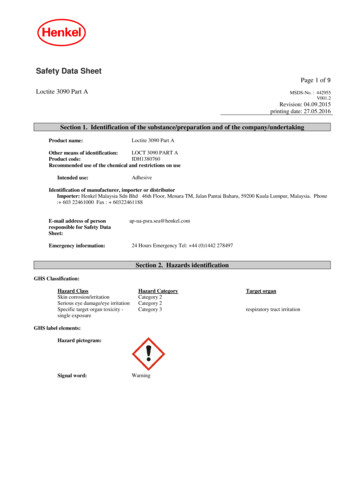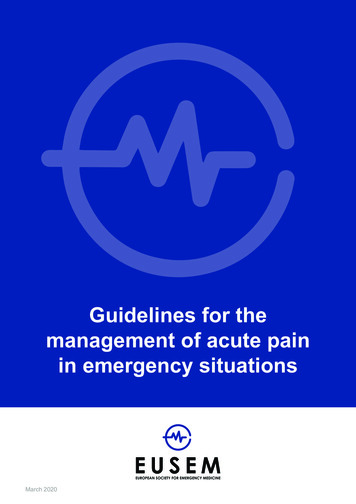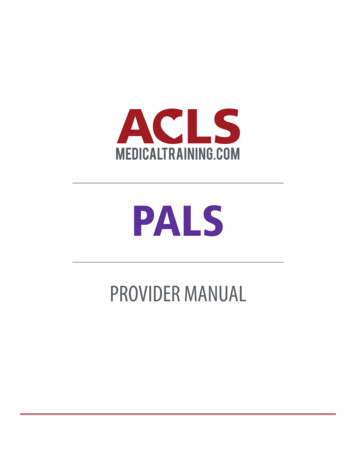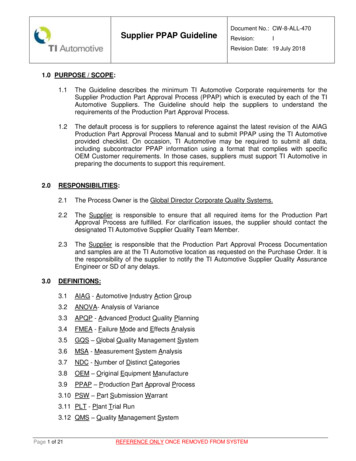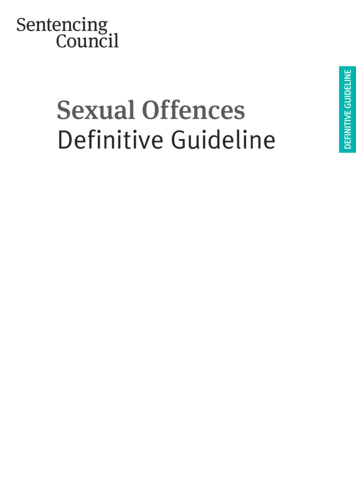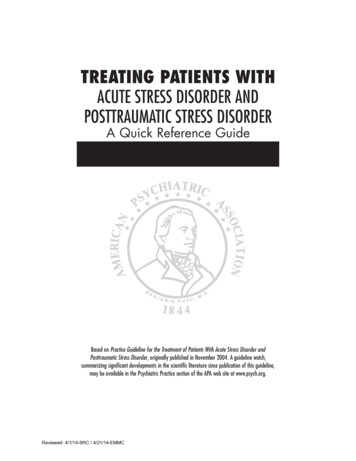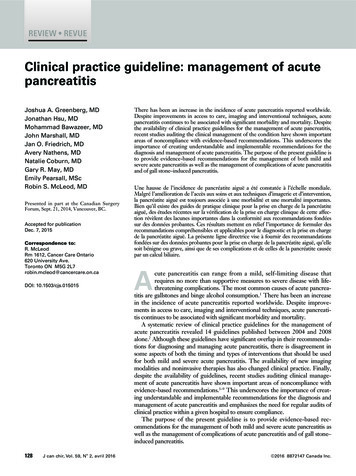
Transcription
Acute Wheeze Guideline in ChildrenSubject:Acute Wheeze Guideline in childrenPolicy NumberRatified By:N/AClinical Guidelines Committee (v1)UCLP children’s asthma network group (v2)Original (November 2010), Reviewed withagreement from UCLP children’s asthmanetwork group, June 20152.0Dr John MoreirasDr Elinor Sefi, Dr Benita Morrissey, ColetteDatt and Dr John MoreirasAs aboveJune 20153 years hencePaediatric, Emergency DepartmentAsthma, Wheeze, childDate Ratified:Version:Policy Executive Owner:Designation of Author:Name of Assurance Committee:Date Issued:Review Date:Target Audience:Key Words:Acute Wheeze Guideline in childrenDate 01/05/2015.Version 2Page 1
Version Control SheetVersion12DateNovember 2010June2015AuthorNeeta PatelStatusOff lineDr Elinor Sefi,Dr BenitaMorrissey,Colette Datt andDr JohnMoreirasLiveCommentVersion 1. Approved at ClinicalGuidelines Committee, 2010This guideline was written by Dr ElinorSefi, Dr Benita Morrissey, Colette Dattand Dr John Moreiras on behalf of theUCLP children’s asthma networkgroup. It was designed to be used byall hospitals in the network. It has beenmodified slightly to fit in with workingpractice within the Whittington Hospital¾ Criteria for useThis guideline was written by Dr Elinor Sefi, Dr Benita Morrissey, Colette Datt and Dr JohnMoreiras on behalf of the UCLP children’s asthma network group. It was designed to beused by all hospitals in the network. It has been modified slightly to fit in with workingpractice within the Whittington HospitalAcute Wheeze Guideline in childrenDate 01/05/2015.Version 2Page 2
¾ Contents1. IntroductionPage22. Assessing the child with wheeze33. Assessing severity54. Ensuring the correct diagnosis65. Wheeze in the pre-school child76. Acute wheeze flow-chart87. Medication doses in acute asthma98. The evidence for acute asthma management109. The deteriorating child with asthma1310. Weaning asthma inhalers1511. Discharge planning and criteria1612. Asthma education and plans1713. Asthma control1814. Preventer therapy1915. Other helpful resources2016. Appendices:a. Paediatric wheeze pathway21b. Wheeze fact sheet28c. Asthma plans30d. NICE quality indicators31e. Peak flow32f.33Drug labels17. References34In an emergency:Click here to go straight to the Acute Asthma flow-chart.OR CATS retrieval serviceAcute Wheeze Guideline in children0800 085 0003Date 01/05/2015.Version 2Page 3
(1) IntroductionAsthma affects 1.1million children in the UK. Many more pre-school children experienceacute wheeze each year with viral infections. Acute wheeze is one of the commonestreasons for attendance to the emergency department and admission to hospital in children.Up to 75% of these admissions are thought to be avoidable. Evidence-based clinicalpathways and guidelines have been shown to improve outcomes for children with acutewheeze and asthma, and reduce hospitalisation.This integrated clinical guideline has been developed for children (between 2 and 16 yearsof age) with acute wheeze presenting to hospital. Recommendations are based on the bestavailable evidence. Children under two years are more likely to have an alternativediagnosis and may respond inconsistently to bronchodilators and therefore are not includedin this guideline.The guideline has been developed for hospitals within UCL partners, to be used inemergency departments, paediatric ambulatory units and in-patient paediatric wards. It hasbeen developed in collaboration with primary, secondary and tertiary care and the Children’sAcute Transport Service. It includes an acute wheeze admission proforma and quickreference flow charts for use in a busy emergency department as well as links to asthmaplans and checklists for discharge.To go straight to the acute asthma management flow-chart click here.Acknowledgments and ContributionsWe would like to thank all the members of the UCLP asthma network who have contributedto this guideline.Related Whittington guidelines Paediatric allergy guidelineSyncathen guidelineAcute Wheeze Guideline in childrenDate 01/05/2015.Version 2Page 4
(2) Assessing the child with wheeze2.1. HistoryTaking a full history is an important step in assessing children with acute wheeze but shouldnot delay starting treatment particularly in severe and life-threatening episodes.1Always consider the following:1. Is this really asthma? – See “Ensuring the correct diagnosis.”2. If this is asthma, is it well controlled?3. If it is not well controlled, what are the reasons for this?This is an important opportunity to identify children with poor control,and to do something about it.3Take a focused medical history including: The acute episode: symptoms, duration, triggers and prior drug treatment (includingdosages, frequency of use, delivery method, time of last dose and response totreatment) Background asthma control: ask about interval symptoms, in particular symptoms withexercise, symptoms at night and need for rescue Salbutamol2 – the Asthma Control Testis a useful tool for assessing background asthma control. Medication history (including dosages, delivery and frequency of use). More than oneprescription per month of salbutamol and fewer than one prescription per month ofinhaled steroids (if prescribed) may be a marker of poor control/adherence4 Prior hospitalisations with acute wheeze (including previous life-threatening episodesand any admissions to HDU and ICU) Prior visits to GP/Emergency Department (ED) with acute asthma and number ofcourses of systemic steroids in last six months. Number of repeat prescriptions forinhalers. Co-existing medical conditions (particularly allergic rhinitis, hay fever, eczema andallergies Take a detailed food allergy history (Which foods? Time to reaction? Describe reaction) Family and social history (including family history of atopy, smokers at home and pets) Number of school days missed due to asthma Use of complementary therapies: this may be associated with poor adherence toprescribed therapies Triggers; exercise, smoking, hay fever, animals, infections etc. Further information on Eczema can be found: https://www.nice.org.uk/guidance/cg572.2 Young people and adolescents5 See young people and adolescents on their own for part of the consultation Ask if they smoke – if they do offer them advice to stop and signpost to local NHSsmoking cessation services. If they do not smoke, encourage them to avoid tobacco smoke and urge them not to startsmoking Ask about drugs and symptoms of anxiety and depression. These are significantly moreprevalent amongst young people with asthma.6Acute Wheeze Guideline in childrenDate 01/05/2015.Version 2Page 5
2.3 ExaminationAssess child on presentation using a structured approach (airway, breathing, circulation anddisability) and record vital signs (pulse rate, respiratory rate and oxygen saturations.)Level of activity (or alertness) and work of breathing are important parameters in assessingthe severity of the wheeze episode, along with initial oxygen saturations in air. Wheezing isnot a good marker of severity, as with increasing obstruction it may become bi-phasic or lessapparent.Often the priority is to do a respiratory examination, assess severity (next section) and starttreatment. Then proceed to perform a full physical examination, including checking peakflow (if child is over five years and familiar with performing peak flow.) Plot height and weighton a growth chart.Red Flags:A silent chest, drowsiness, agitation or confusion are signs of a lifethreatening episode. Call for senior help and anaesthetic supportimmediately2.4 Investigations Peak flow measurement can be helpful in assessing severity and response to treatmentin children over five years who are familiar with the technique.The best of three Peak Expiratory Flow (PEF) measurements ideally expressed, as apercentage of personal best can be useful. (See Appendix: PEF chart)Peak flows should not be used for children with life-threatening asthma. Clinicalassessment of severity may be more reliable especially in children under 10 years andthose unfamiliar with these devices or who have poor technique.7 Chest X-rays – chest X-rays rarely provide additional information and are not routinelyindicated.8 A chest X-ray should be performed if there is subcutaneous emphysema,persisting unilateral signs suggesting pneumothorax, lobar collapse, a foreign body, orconsolidation, an atypical history in a child with a first presentation of wheeze or lifethreatening asthma not responding to treatment. Blood gas analysis should be avoided if possible as it may cause distress and furtherrespiratory compromise. The child’s clinical state is a better guide to treatment. Capillarysampling can be considered if there are life-threatening features not responsive totreatment, or uncertainty about the clinical diagnosis. A normal or raised pCO2 indicatesworsening asthma.Acute Wheeze Guideline in childrenDate 01/05/2015.Version 2Page 6
(3) Assessing severityIt is important to assess the severity of the wheeze episode on presentation and classify intomild, moderate, severe or life threatening.5 This will allow ensure that the correcttreatment is given.If any feature is present (severe and life threatening), this will automatically put the patient inthis group.Clinical FeaturesAlertnessActivity eart Rate 94% in airRespiratory RateWork ofBreathingPeak Flow 5yrs 140 5yrs 125 5yrs 40 5yrs ressedNormalReducedAble to talk in Too breathless toshorttalk/feedsentences 92% air 92% air 5yrs 140 5yrs 125 5yrs 40 5yrs 30Someincrease.Mild tomoderaterecession andaccessorymuscle use 50-75% bestor predictedAcute Wheeze Guideline in children 5yrs 140 5yrs 125 5yrs 40 5yrs 30Markedlyincreased.Moderate tosevere recession,marked accessorymuscle use33-50% best orpredictedDate onNone 92% on oxygenCyanosisBradycardia orhypotensionSevere recession/poor respiratoryeffort or silentchestNot appropriateVersion 2Page 7
(4) Ensuring the correct diagnosisAsthma causes recurrent respiratory symptoms of wheezing, cough, difficulty breathing, andchest tightness in children due to variable airway obstruction.Asthma is a clinical diagnosis in children.5It is made more likely if these symptoms arefrequent and recurrent, worse at night and in the early morning, worse after exercise or withother triggers (such as exposure to pets, cold or damp air or with emotions,) and occur apartfrom colds.Asthma is also more likely if children have other atopic conditions (such as eczema, allergicrhinitis or allergies,) or a family history of atopy or asthma.The following are found less often in children with asthma, and may be clues to alternativediagnoses in wheezy children:5Clinical ClueSymptoms present from birth or neonatalperiodFamily history of respiratory diseaseSevere upper respiratory tract diseaseExcessive vomitingBreathlessness with light-headednessand peripheral tinglingPersistent moist coughInspiratory StridorAbnormal voice or cryFocal signs in chestFinger clubbingFailure to thriveFocal or persistent CXR changesTachypnoea without wheezeNew onset of wheeze in older child /orthopnoeaAcute Wheeze Guideline in childrenAlternative diagnoses to considerCongenital lung abnormality, cystic fibrosis,chronic lung disease of prematurity, ciliarydyskinesiaCystic fibrosis, immunodeficiency,neuromuscular disorder.Ciliary dyskinesia, immunodeficiencyGastro-oesophageal reflux diseaseHyperventilation/panic attacksCystic fibrosis, bronchiectasis, recurrentaspiration, ciliary dyskinesia,immunodeficiencyTracheal or laryngeal disorderLaryngeal problemInhaled foreign body, congenital abnormality,bronchiectasis, pneumoniaCystic fibrosis, bronchiectasis.Cystic fibrosis, immunodeficiency, gastrooesophageal refluxCongenital abnormality, cystic fibrosis,recurrent aspiration, bronchiectasis,tuberculosisSevere acidosis e.g. DKA, renal failureMediastinal massDate 01/05/2015.Version 2Page 8
(5) Wheeze In the pre-school childAcute wheeze, with viral upper respiratory tract infections, is very common in pre-schoolchildren. The vast majority of these children do not have asthma – and most will havestopped having episodes of wheeze by the age of six.Pre-school wheeze has a different natural history and pathophysiology to childhood asthma,and children with pre-school wheeze often respond differently to asthma treatment(particularly corticosteroids.)It is helpful to classify children with pre-school wheeze into two phenotypes:91. Episodic Viral Wheeze – Child only wheezes with viral upper respiratory tract infectionsand is symptom-free in between episodes.2. Multi-trigger Wheeze – Child wheezes with upper respiratory tract infections but alsowith other triggers such as exercise, smoke and allergen exposure.Prednisolone should not be given to pre-school children with wheeze who are well enough tobe managed in the community. In children admitted to hospital it should not be usedroutinely in children with episodic viral wheeze.9Prednisolone should be considered in children with multi-trigger wheeze and children withepisodic wheeze with severe or life-threatening exacerbations, particularly those who requirehigh dependency or intensive care.For further information – see the review article: Managing wheeze in pre-school children.Acute Wheeze Guideline in childrenDate 01/05/2015.Version 2Page 9
(6) Acute Wheeze Flow Chart for Children 2-16 yearsStart by assessing severity and treat according to most severe featuresMild SaO2 94% air Mild recession Mild to moderatewheezeModerate SaO2 92% air Can talk in shortsentences Moderate recessionand wheeze SevereSaO2 92% in air 5yrs: RR 40, HR 140 5yrs: RR 30, HR 125Unable to talk/feedMarked recession Life threateningSaO2 92% in O2Pallor/ cyanosisPoor respiratory effortAgitatedreduced GCSSilent chestCALL FORHELPGive Oxygen if needed to keep saturations 93%.Salbutamol via spacerSalbutamol via spacerReassess after 20minutes and repeat ifneeded up to 3 dosesOral prednisolone if: Known asthmatic 5 years old Consider if 5 years andmulti-trigger wheezeConsider oralprednisolone if:Needs 1 dosesalbutamol and/or: Known asthmatic 5 years old 5 years with multitrigger wheezeIf poor response to firstsalbutamol addipratropium to remainingsalbutamol Burst.Complete burst therapy ofsalbutamol andipratropium every 20minsfor 1st hourBurst therapy ofSalbutamol andipratropium via spacer(nebuliser if not toleratingspacer or sats 92%) every20minutesOral prednisolone, (or IVhydrocortisone if vomiting)REASSESS and if poorresponse: Repeat burst: IV magnesium bolus IV salbutamol bolus /infusionHigh flow oxygenBack to back nebulisedsalbutamol andipratropium Obtain IV access U&E and blood gas IV hydrocortisone IV magnesium bolusREASSESS and if poorresponse: Continue nebulisers Give IV salbutamolbolus and then infusionor if salbutamol toxicity,give IV aminophylline Call consultant /anaethetist and CATSAssess response to treatment after 1 hour and 2 hours and re-categoriseMILDSafe to discharge if stableand only requiringSalbutamol every 3-4hoursMODERATESEVEREKeep O2 SaO2 93%Continue salbutamolevery 1-3 hrs as neededKeep O2 SaO2 93%Continue salbutamolevery 30-60 minutesComplete 3 days ofprednisolone if started.Safe to discharge whenonly requiring salbutamolevery 3-4 hoursContinue ipratropiumevery 20 minutes for first2 hours and then every 4hoursDischarge with asthmaplan.Complete 3 days ofprednisolone if started.Advise review within 48hours by GPGive asthma plan.Advise review within 48hours by GPAcute Wheeze Guideline in childrenReassess frequentlyIf no improvement and notalready done so give: IV magnesium IV salbutamol bolus /infusionDate 01/05/2015.LIFE THREATENINGContinue nebulisersGive IV salbutamol /aminophylline if notalready done so.Consider 2nd dose IVmagnesium antibioticsCall anaesthetist andCATSDo CXR and gasIf deteriorating considerintubation and ventilationVersion 2Page 10
(7) Medication doses for acute asthmaMedicationRoute ofadministrationDose 5 yearsDose 5 yearsCommentsSalbutamolMDI and spacer5-10 puffs10 puffs1 puff 100mcgNebuliser2.5mg5mgIpratropium Bromide(Atrovent)MDI and spacer20 mcg (I puff) x 320 mcg (1 puff) x 6Nebuliser 2 years 125mcg2-12 yrs 250mcg2-12 years 250 mcg 12 years 500 us4mg/kg every 6 hours (max 100mg)Or if weight unavailable use: 2 years 25mg2-5 years 50mg 5 years 100mgMagnesium SulphateIntravenousBolus40mg/kg (max 2g)Consider carefully if 5 years (seeguideline)Give if vomiting orlife-threateningepisode of wheezeIf overweight use “ideal weight” based ontheir height centile or chart in back of cBNFSalbutamolIntravenous bolusPlease use theSalbutamol sticker (kept inHDU on Ifor & ED)IntravenousInfusion 2 years 5mcg/kg 2 years 15mcg/kg (max 250mcg)If overweight use “ideal weight” based ontheir height centile or chart in back of cBNF1-2 mcg/kg/min (If weight over 40kg,calculate rate on 40kg)If overweight use “ideal weight” based ontheir height centile or chart in back of cBNFAminophyllinePlease use theAminophylline sticker(kept in HDU on Ifor &ED)Intravenousloading doseIntravenousinfusion20-40 mcg every 20min for first 2 hrs5mg/kg (max 500mg)If overweight use “ideal weight” based ontheir height centile or chart in back of cBNF 12 years 1mg/kg/hr 12 years 0.5-0.7 mg/kg/hrGive over 20 minBP Cardiac monitor*Can repeat within 1-2hrs (further dosesneed Mg Levels)Single bolusGive over 3-5minutesCardiac monitor*Monitor side effectsincluding lactate andK .Cardiac monitor*Loading not needed ifon oralaminophylline. Giveover 20-30 minsCardiac monitor*Give antiemeticsCardiac monitor*Give antiemeticsLevels 4-6 hrsIf overweight use “ideal weight” based ontheir height centile or chart in back of cBNF Bronchodilator therapy through MDI (Metered Dose Inhaler) with spacer should be firstline as it is associated with fewer side effects.Acute Wheeze Guideline in childrenDate 01/05/2015.Version 2Page 11
(8) The evidence for acute asthma management8.1 OxygenOxygen should be given to all children with oxygen saturation levels 94%.In life-threatening asthma give oxygen via a non-rebreathe mask (15 litres/minute.)In severeasthma, oxygen can be given by nasal cannula or a facemask. Aim to keep oxygensaturations at 94-98%. Care should be taken not to over administer oxygen as this maymask signs of deterioration in moderate and severe asthma. Remember Oxygen should beprescribed.8.2 SalbutamolSalbutamol should be given to all children presenting acutely with wheezewithin 10 minutes of their arrival.10Salbutamol is a short acting beta-2agonist, which should be used as first line bronchodilatortherapy in childhood wheeze. Itcan be given by metered dose inhalers (by spacer) or bynebuliser. Both routes are equally efficacious as long as the doses used are sufficient (seemedication doses.) In children giving Salbutamol via a spacer (as opposed to a nebulizer)results in less tachycardia and tremor and a reduced time in the emergency department,particularly for children with mild-moderate exacerbations.11An oxygen requirement is not necessarily a contraindication to the use of spacers; Spacershave been shown to be safe and well tolerated even in severe asthma.12 A spacer with afacemask should be used for children under 5 years, and a spacer with a mouthpiece forchildren over 5 years. In children with moderate, severe and life-threatening wheeze givethree doses of Salbutamol over the first hour in the ED.Intravenous Salbutamol. There is limited evidence to support this from two small studies.Children who received IV Salbutamol had shorter recovery times and more rapid clinicalimprovement than those who received standard therapy.13-15 Currently the British ThoracicSociety guidelines recommend consideration of a single bolus dose of intravenousSalbutamol in severe cases where the child has not responded to initial inhaled therapy.Side effects of salbutamol can include tachycardia, tremor, hypokalaemia,headache, lactic acidosis, arrhythmias and palpitations and very rarely urticariaand paroxysmal bronchospasm. If the heart rate is 200 consider stoppingsalbutamol. If lactic acidosis is worsening or signs salbutamol toxicity, while onIV salbutamol the rate may need to be reduced or stopped altogether. Discuss withconsultant on call regarding other supportive medication (i.e. Magnesium Sulphate,Aminophylline etc.)8.3 PrednisolonePrednisolone should be given as soon as possible afterarrival in the ED, and always within the first hour.Acute Wheeze Guideline in childrenDate 01/05/2015.Version 2Page 12
Early administration of Prednisolone to children with acute asthma reduces hospitaladmission and results in reduced beta-2agonist use and earlier recovery.16The earlierPrednisolone is given, the less likely a child is to need admission to hospital.1718In children with severe asthma, no significant difference has been found between oral andintravenous steroids.19 Intravenous corticosteroids (IV hydrocortisone) should be reservedfor children with life-threatening asthma or where there is vomiting or concern regarding theabsorption of oral corticosteroids.Make up prednisolone in a concentrated solution, as its taste can be unpleasant. Pleaseprescribe prednisolone tablets .The tablets can be crushed and mixed with water readily.The soluble tablets are reserved for children 2yrs, or who do not tolerate the crushedtabletsChildren should be given a three-day course of steroids unless they remain hospitalised atthree days in which case a five-day course can be considered.20Prednisolone should not be used routinely in children with episodic viral wheeze – seeWheeze in pre-school children.There is no need to wean steroids if the course is 2 weeks.Children on long-term oral steroids should carry a steroid card.Consider the possibility of adrenal insufficiency in sick children on regular highdose inhaled steroids.8.4 Ipratropium BromideGive Ipratropium Bromide with each dose of Salbutamolto all children with severe asthma for the first hour.In moderate asthma, give after the first dose of Salbutamol if there is a poor response.Anticholinergics have a slower onset of action and weaker bronchodilating effect than shortacting beta2-agonists but may specifically relieve cholinergic bronchial tone and reducemucosal oedema. The addition of anticholinergics (usually 2-3 doses) to Salbutamolsignificantly reduced the risk of hospital admission. Children also showed a greaterimprovement in lung function, and experience less nausea and tremor.21Side effects may include nausea, diarrhoea, constipation, headache anddizziness.8.5 Magnesium SulphateGive IV magnesium sulphate to children with severe asthma who haveresponded poorly to initial burst therapy, or have on-going signsof a severe exacerbation at 1 hour.In children with life-threatening asthma IV magnesium sulphate shouldbe given alongside burst therapy.The use of intravenous magnesium sulphate, in addition to Salbutamol and systemicsteroids, is associated with a significant improvement in respiratory function and reduction inAcute Wheeze Guideline in childrenDate 01/05/2015.Version 2Page 13
hospital admission in children with moderate to severe asthma. Nebulised magnesiumsulphate only appears to have beneficial effects in adults. 22 23Intravenous infusion of magnesium sulphate during the first hour of hospitalization in patientswith acute severe asthma significantly reduced the percentage of children who requiredmechanical ventilation support. 24Magnesium Sulphate can be repeated within in 1-2 hours. Serum magnesium levelmeasurement is indicated if further doses are being considered. There is insufficientevidence comparing IV magnesium sulphate versus IV Salbutamol for acute severe asthmain children.Side effects: Intravenous magnesium sulphate has been well tolerated instudies, but can cause hypotension so monitor blood pressure throughout.Flushing, pain at infusion site, a dry mouth, and facial warmth have also beendescribed. 258.6 AminophyllineAminophylline is not recommended as first-line therapy for children with severe acuteasthma, but should be considered as an additional therapy in children who have notsufficiently responded to IV Salbutamol or Magnesium, or who have developed toxicities withthese.It may be useful early in treatment in children who present with severe or life threateningasthma who have received multiple doses of salbutamol prior to presentation and areshowing toxicity or poor response to salbutamol.The use of intravenous aminophylline has not been shown to result in additionalbronchodilation or a significant reduction in the risk of hospital admission in patients withacute asthma in the ED, compared to standard care.26In children with a severe asthmaexacerbation, the addition of IV aminophylline to beta2-agonists and glucocorticoidsimproved lung function within 6 hours of treatment. However it had no benefit on symptoms,number of nebulised treatments or length of stay. There is insufficient evidence to assessthe impact on oxygenation, PICU admission and mechanical ventilation.Side Effects include nausea, vomiting, diarrhoea, tachycardia, headaches andarrhythmias. Aminophylline is associated with a threefold risk of vomiting27, sogive with antiemetic cover.8.7 Other TherapiesMontelukast –The use of oral montelukast is not currently recommenced in moderate tosevere asthma exacerbations of asthma. 28 A single dose of oral montelukast added tostandard therapy of inhaled bronchodilators and systemic glucocorticoids, did not provideadditional clinical benefit in children (aged over 5) with acute moderate to severe asthma.29Inhaled Steroids – There is insufficient evidence that inhaled corticosteroid therapy resultsin clinically important changes in respiratory function or clinical scores when used in acuteasthma in addition to systemic corticosteroids.30 In children treated in the ED for acuteasthma a single 2-mg dose of budesonide added to standard therapy did not improveasthma severity scores or other short-term ED-based outcomes. 31Acute Wheeze Guideline in childrenDate 01/05/2015.Version 2Page 14
(9) The Deteriorating child with wheezeMost children with acute severe and life-threatening asthma will respond to initial medicaltherapy. In the very few children that do not respond and have a progressive respiratorydeterioration, intubation and ventilation can be lifesaving. Complications are common postintubation, the most common being hypotension requiring fluid resuscitation.Evidence has shown that maximal medical therapy had only been administered in 31%(9/29) of children who required intubation for progressive respiratory deterioration. 32 Alwaysensure that a child has received maximal medical therapy and consider alternativediagnoses. Early discussion with the paediatric and anaesthetic consultant on call andCATS (Children Acute Transport Service) is essential.Indications for IntubationConsider intubation in any child with the following:o Tiredo Reducing conscious levelo Worsening hypoxaemia* Blood gas analysis on its own is not a substitute for clinical assessment. Need forintubation should not be made solely on a Blood Gas.The CATS website has an Asthma Guideline with specific instructions regarding intubation.To go to the CATS asthma guideline click hereTo make a referral to CATS call 0800 085 0003Acute Wheeze Guideline in childrenDate 01/05/2015.Version 2Page 15
(10) Weaning asthma InhalersBronchodilators should be weaned according to the child’s clinical state.While the child is an inpatient a minimum of hourly assessment while thechild is requiring 1-2hourly salbutamol, and two-three hourly assessment when requiring salbutamol 3-4 hourlyshould be undertaken. This should include assessment of saturations and work of breathingto determine when the next dose of bronchodilator should be given.Wheeze is not a good marker of asthma severity but the return of wheeze may be oneindicator for the requirement of further bronchodilators. If appropriately trained staffareavailable, nurse led weaning and discharge may allow better patient focused weaning anddischarge.A suggested salbutamol-weaning plan on discharge is as follows:Day 1: Give 6 puffs of salbutamol via spacer every 4 hoursDay 2: Give 4 puffs of salbutamol via spacer every 6 hoursDay 3: Give 2 puffs as required using usual inhaler deviceThis is a guide for families and weaning at home should also be guided by the child’scondition and parents should be taught how to assess signs of respiratory distress in theirchildren.Acute Wheeze Guideline in childrenDate 01/05/2015.Version 2Page 16
(11) Discharge PlanningDischarge planning should begin at admission using every opportunity for education of thechild and family throughout the admission.Children are usually ready for discharge when they require salbutamol no more frequentlythan every 4 hours, have no oxygen requirement, are drinking sufficiently and the child,family and medical staff feel comfortable with the child going home.One of the aims at discharge should be to try to minimise the risk of future preventableadmissions through the use of a comprehensive education package.3Asthma education is the responsibility of all health professionals. All children should havetheir inhaler technique checked prior to discharge and should be discharged with writtenasthma information and a personalized asthma action plan (see asthma education below).An assessment of long-term asthma control should be made and preventer therapyconsidered (see asthma control below).Families should be advised to see the GP within 48 hours of discharge. The purpose of thisvisit is to ensure that the acute symptoms are resolving but also to review long term asthmacontrol, to consolidate asthma educati
Dr Benita Morrissey, Colette Datt and Dr John Moreiras Live This guideline was written by Dr Elinor Sefi, Dr Benita Morrissey, Colette Datt and Dr John Moreiras on behalf of the UCLP children's asthma network group. It was designed to be used by all hospitals in the network. It has been modified slightly to fit in with working



